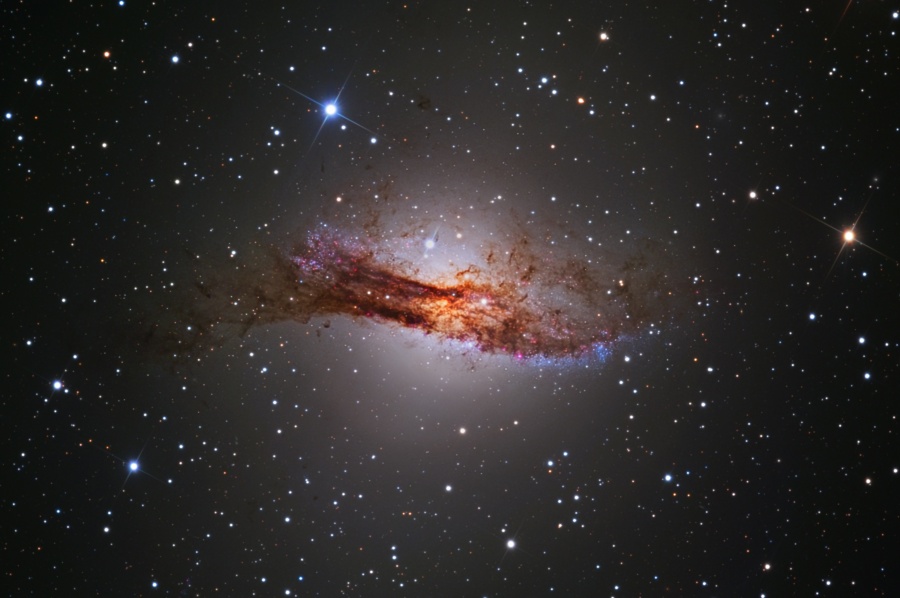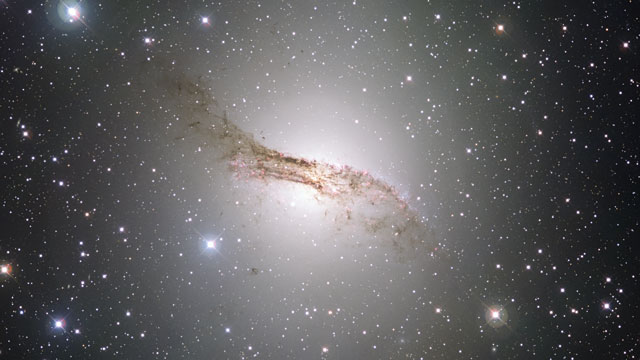NGC3314 wrote:A background note - if I can tear my eyes away from the intricate structure of Centaurs A, near the lower right corner is the galaxy pair NGC 5090/91, of which the elliptical component NGC 5090 is itself the center of a large double radio source. Galaxies stretching away for gigaparsecs and gigaparsecs.
Stephan's Quintet.
NASA, ESA, and the Hubble SM4 ERO Team
Wow, NGC 5090/91 is a very interesting pair! Can you believe how red they are? And above all, how red that spiral galaxy is? Compare the appearance of the spiral and the elliptical component of NGC 5090/91 with the appearance of the spirals and the ellipticals of Stephan's Quintet. (Note that the blue spiral of Stephan's Quintet is a foreground object.) While the yellow spirals of Stephan's Quintet are all contorted and display clear signs of younger stars, the spiral galaxy NGC 5091 is serene and undisturbed, with no obvious signs of young stars.
The color indexes of the NGC 5090/91 pair, as well as the spirals and ellipticals of Stephan's Quintet, are interesting. NGC 5090, the elliptical component of the pair, has an (effective) U-B of 0.705, and an (effective) B-V of 1.130. Both color indexes are very red. NGC 5091, the spiral, is (effective) U-B = 0.670, and (effective) B-V = 1.150. So the the effective B-V of the spiral component is ever so slightly
redder than the effective U-B of the elliptical component! That is because of the dust in the spiral galaxy. The effective U-B of the spiral is very slightly bluer than the effective U-B of the elliptical, suggesting the presence of some young or intermediate stars in the spiral. Still, I find this spiral galaxy incredibly red.
The color indexes of the spirals and ellipticals of Stephan's Quintet are bluer. NGC 7317 at lower right is an elliptical, and its effective U-B is 0.570 and its effective B-V is 0.975. That's clearly bluer than either component of the NGC 5090/91 pair. NGC 7319 at upper left is a distorted spiral, with a total (not effective) U-B of 0.320 and a total B-V of 0.970. The B-V of spiral NGC 7319 is barely bluer than the B-V of elliptical NGC 7317, but the U-B values differ considerably. And NGC 7318A has an effective B-V of 1.030, but a total U-B which is as low as 0.290. The relatively low U-B indexes of the Stephan Quintet spirals are a clear indication that they contain quite a lot of young stars.
Interestingly, the spirals and ellipticals of Stephan's Quintet (except the foreground galaxy) are
farther away from us than NGC 5090/91,
210-340 million light-years for Stephan's Quintet, whereas NGc 5090/91 have somewhat lower recession velocities, suggesting they are closer to us. And yet, the NGC 5090/91 pair is so red! Why is that?
Today's APOD provides a possible answer. There is clearly Milky Way dust in the vicinity of the NGC 5090/91 pair, likely reddening them.
Ann
 Centaurus A
Centaurus A


